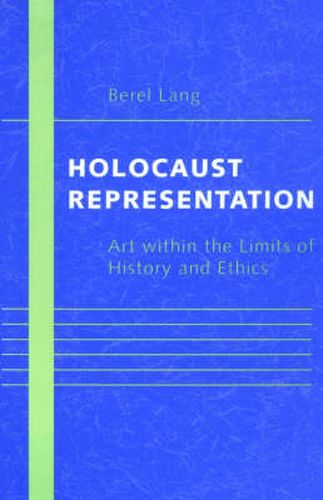Readings Newsletter
Become a Readings Member to make your shopping experience even easier.
Sign in or sign up for free!
You’re not far away from qualifying for FREE standard shipping within Australia
You’ve qualified for FREE standard shipping within Australia
The cart is loading…






Since Theodor Adorno’s attack on the writing of poetry after Auschwitz , artists and theorists have faced the problem of reconciling the moral enormity of the Nazi genocide with the artist’s search for creative freedom. In this study, Berel Lang addresses the relation between ethics and art in the context of contemporary discussions of the Holocaust. Are certain aesthetic means or genres out of bounds for the Holocaust? To what extent should artists be constrained by the actuality of history - and is the Holocaust unique in raising these problemsof representation? The dynamics between artistic form and content generally hold even more intensely, Lang argues, when art’s subject has the moral weight of an event like the Holocaust. As authors reach beyond the standard conventions for more adequate means of representation, Holocaust writings frequently display a blurring of genres. The same impulse manifests itself in repeated claims of historical as well as artistic authenticity. Informing Lang’s discussion are the conflicts about the truth-status of Benjamin Wilkomirski’s memoir
Fragments and the comic fantasy of Roberto Benigni’s film Life Is Beautiful . Lang views Holocaust representation as limited by a combination of ethical and historical constraints. As art that violates such constraints often lapses into sentimentality or melodrama, cliche or kitsch, this becomes all the more objectionable when its subject is moral enormity. At an extreme, all Holocaust representation must face the test of whether its referent would not be more authentically expressed by silence - that is, by the absence of representation.
$9.00 standard shipping within Australia
FREE standard shipping within Australia for orders over $100.00
Express & International shipping calculated at checkout
Since Theodor Adorno’s attack on the writing of poetry after Auschwitz , artists and theorists have faced the problem of reconciling the moral enormity of the Nazi genocide with the artist’s search for creative freedom. In this study, Berel Lang addresses the relation between ethics and art in the context of contemporary discussions of the Holocaust. Are certain aesthetic means or genres out of bounds for the Holocaust? To what extent should artists be constrained by the actuality of history - and is the Holocaust unique in raising these problemsof representation? The dynamics between artistic form and content generally hold even more intensely, Lang argues, when art’s subject has the moral weight of an event like the Holocaust. As authors reach beyond the standard conventions for more adequate means of representation, Holocaust writings frequently display a blurring of genres. The same impulse manifests itself in repeated claims of historical as well as artistic authenticity. Informing Lang’s discussion are the conflicts about the truth-status of Benjamin Wilkomirski’s memoir
Fragments and the comic fantasy of Roberto Benigni’s film Life Is Beautiful . Lang views Holocaust representation as limited by a combination of ethical and historical constraints. As art that violates such constraints often lapses into sentimentality or melodrama, cliche or kitsch, this becomes all the more objectionable when its subject is moral enormity. At an extreme, all Holocaust representation must face the test of whether its referent would not be more authentically expressed by silence - that is, by the absence of representation.